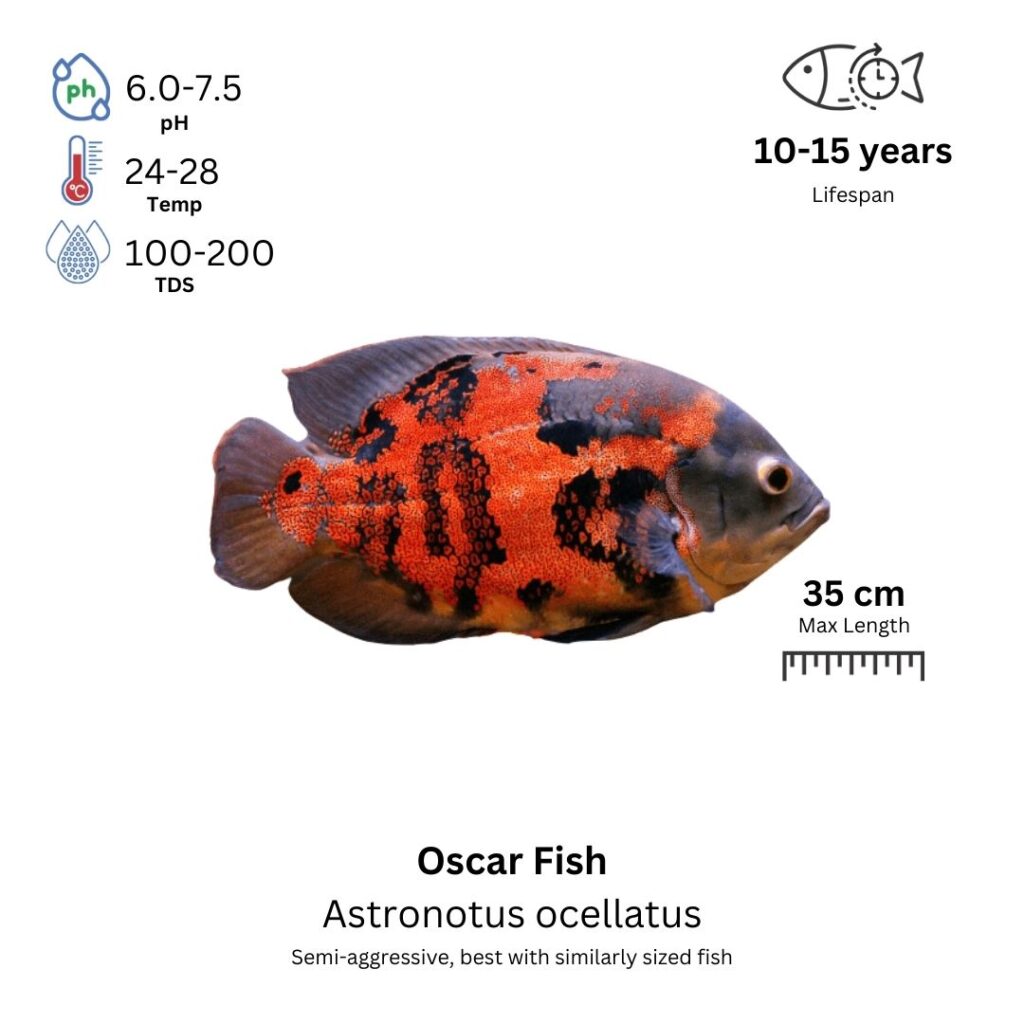Oscar Fish
Astronotus ocellatus

Description
The Oscar Fish is a large and highly intelligent cichlid known for its vibrant colors and bold personality. Oscars can exhibit a variety of colors depending on their environment and breeding status. In general, they have a base color ranging from dark green to black, with bright orange, red, or yellow accents along their bodies. Their bodies are round and robust, with large, expressive eyes and a slightly flattened shape. Oscars are also known for their distinctive patterning, which can include spots or marbling, especially in certain color morphs.
Habitat Origin
Native to South America, Oscars are primarily found in slow-moving rivers, lakes, and floodplains, particularly in the Amazon and Orinoco River basins. They inhabit warm, murky waters with plenty of submerged structures like rocks and fallen branches, which provide cover and hunting opportunities. These fish prefer slightly acidic to neutral water and are typically found in environments that have low to moderate water flow. Their natural habitat is often rich in organic matter and vegetation.
Aquarium
Ideal Number in Aquarium: Best kept singly or in pairs. Oscars can be very territorial, and keeping multiple Oscars in a small tank can result in fighting.
Favorite Food

Oscars are carnivores and require a protein-rich diet. They can be fed a variety of foods, including high-quality cichlid pellets, live or frozen foods such as brine shrimp, bloodworms, earthworms, and small fish. They may also enjoy occasional treats of crickets or small invertebrates. A varied diet is essential for maintaining their health and vibrant coloration.
Behavior:
Oscars are highly active and intelligent fish. They are known for their curious nature and will often interact with their owners, especially at feeding times. They are territorial and can be aggressive toward other fish, especially if the tank is too small or there aren’t enough hiding places. When Oscars feel threatened or challenged, they may exhibit their aggressive behavior by flaring their gills and chasing other fish away. Despite their aggression, Oscars are also known to become “tame” over time, with some individuals even learning to recognize their owners and respond to hand movements. They are also known to rearrange objects in the tank, such as rocks or decorations, as part of their natural behavior.
Special Care:
Oscars require a spacious tank with plenty of hiding spots, as they can be territorial. It is important to provide them with a soft substrate, such as sand or smooth gravel, as they tend to dig around and move objects in their tank. Since they are messy eaters, regular water changes and a powerful filtration system are necessary to maintain water quality. Oscars produce a large amount of waste, so ensuring good filtration is key to maintaining a healthy environment.
Compatibility with Other Fish:
Oscars are best kept with other large, robust fish that can tolerate their aggressive nature. They are generally not suitable for community tanks with smaller fish, as they may see them as prey or try to bully them. Good tankmates include other large cichlids, larger catfish, and similarly sized fish that can hold their own. Oscars should not be housed with smaller, peaceful fish, as they will likely harass or eat them. It’s essential to provide enough space in the tank and include hiding spots for all fish to reduce stress.
Breeding Tank Setup
Oscar Fish require a dedicated breeding tank due to their territorial and sometimes aggressive nature during spawning. A minimum tank size of 200 liters (50 gallons) is recommended to provide sufficient space for a breeding pair to swim and establish territories. Maintain water parameters with a pH of 6.5–7.5, temperature of 26–30°C, and hardness between 8–15 dGH. Use a powerful but gentle filtration system, such as a canister or high-flow internal filter, to manage their high waste output without creating strong currents. For spawning, provide smooth flat surfaces like rocks or ceramic tiles on a soft sand or fine gravel substrate. Live plants are not necessary, as Oscars may uproot them. A 12-hour standard light cycle supports a natural day-night rhythm.
Conditioning for Breeding
To prepare Oscar Fish for breeding, feed them a high-protein and varied diet. Include live or frozen foods such as brine shrimp, bloodworms, earthworms, and daphnia, along with high-quality pellets or flakes to support complete nutrition. Conditioning should last several days to ensure the fish reach peak reproductive health. Prior to breeding, perform a 20–30% water change and slightly increase the temperature to around 28°C to replicate natural environmental triggers that stimulate spawning.
Spawning Process
Spawning typically takes place in the morning after a pair has bonded. The female will lay 1,000–3,000 adhesive eggs on a flat surface, and the male fertilizes them shortly after. Unique among many fish, both parents stay with the eggs, guarding and fanning them to provide oxygen and remove debris. There is no need to remove the breeders, but all other tankmates should be taken out to prevent disturbances or threats to the eggs.
Fry Hatching
The eggs hatch within 2–3 days, depending on the water temperature. Initially, the fry feed on their yolk sacs. Once they are free-swimming (around 4–5 days post-hatch), begin feeding them with infusoria or newly hatched brine shrimp. As they grow, you can gradually introduce finely crushed flakes or small pellets. Perform regular 10–15% water changes every 2–3 days, and use a sponge or low-flow filter to maintain high water quality without harming the fry. Keep the temperature consistent at around 28°C to support healthy development.
Additional Tips
Oscar Fish reach sexual maturity at around 1–2 years of age. Males are generally larger with more defined head humps, while females are rounder when gravid. To avoid stress, do not overcrowd the tank, and maintain stable water conditions without sudden fluctuations. Aggressive or unrelated fish should never be kept in the breeding tank. A calm, spacious, and clean environment is essential for encouraging natural breeding behavior and ensuring the survival of eggs and fry.
